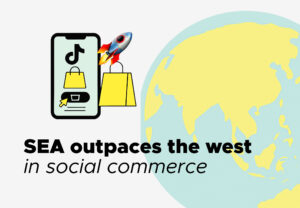Southeast Asia’s Dominance in Social Commerce Trends
The social commerce revolution is being led by Southeast Asia, where platforms have successfully integrated entertainment with instant purchasing capabilities. The region's shoppertainment model has created a blueprint for the industry's future. As 68% of SEA e-commerce retailers increase social commerce investments, Western brands should take notes to shift from traditional website-driven sales to consumer-preferred purchasing experiences.
June 18, 2025

The global social commerce landscape is experiencing phenomenal expansion, with market valuations projected to surge from $1.3 trillion in 2023 to $8.5 trillion by 2030, representing a CAGR (compound annual growth rate) of 26.2%. This trajectory indicates more than just incremental growth. It indicates a fundamental restructuring of how commerce operates in the digital economy. And if you’re looking for the epicenter of this transformation, it’s not New York, Berlin, or even Beijing. It’s Southeast Asia.
From the Philippines to Indonesia, Vietnam to Malaysia, consumers are completely changing how commerce works, fueling an ecosystem where platforms, creators, and communities are powering real-time, feed-native buying behaviors. According to Shopify, 68% of Southeast Asian e-commerce retailers planned to increase their investments in social commerce in 2024.
So, what’s fueling this momentum? And more importantly, what should brands in Europe and the U.S. take away from it?
Why Southeast Asia Leads the Social Commerce Curve
SEA has established itself as the global hub of social commerce innovation, not through circumstance but through deliberate structural advantages that create unbeatable competitive barriers.
📲Mobile-First Digital Architecture
With smartphone penetration rates reaching 91.7% in developed markets and 68.9% in emerging economies, Southeast Asia skipped over traditional desktop commerce frameworks completely. This structural choice allows for smooth integration of social-to-commerce that Western markets find difficult to duplicate within their current systems. This boosts platform-native behaviors where social, search, content, and commerce converge seamlessly.
🤝Trust Mechanism
The region’s inherently communal culture has fostered group-buying behavior, live auctions, and comment-driven product demand, something the West’s individualistic commerce infrastructure isn’t naturally built for. 82% of consumers purchased items based on influencer recommendations. But what’s even more important is how the community backs these choices. Real-time feedback from others gives buyers quick confidence thanks to clear and visible buying habits.
💳Payment Ecosystem
SEA’s payment system shows a good grasp of what people want. About 79% of people are using mobile wallets. But there’s also a solid support for cash-on-delivery, which 77% of people still like. This approach creates a payment system that includes everyone, making sure it caters to both modern and traditional choices.
💁🏽Live Commerce Integration
Southeast Asia has really nailed this thing called ‘shoppertainment‘ i.e., the economic fusion of entertainment value and commerce conversion. It’s not just content marketing changing over time, it’s a whole new way of doing business. Here, people engage with content that leads directly to purchases, turning entertainment into revenue streams.
🧑💻Rooted Creator Economies
Creators in Southeast Asia are not aspirational figures, they are relatable intermediaries. Livestream sellers, TikTok product reviewers, and even WhatsApp resellers function as trusted commerce mechanisms. This has built a culture where product discovery, validation, and purchase all happen within the creator-consumer interaction loop, making creators far more influential than traditional ads.
Strategic Preparation Framework for Europe and USA
The Western e-commerce ecosystem still operates in silos where social drives awareness, websites drive conversion, and creators are used sporadically. That’s a structure increasingly at odds with platform-native consumer behavior. Here’s how to course-correct:
🚀 Revamp Commerce Model
Stop relying solely on owned channels. Embrace a distributed commerce approach where platforms, creators, and communities co-own the buyers journey.
🤝 Focus on Creator Partnerships
Build long-term commerce partnerships with creators, not just for awareness, but for recurring sales. Give them the tools and freedom they need to act like sales reps.
🛒Make Checkout Flows Seamless
Social commerce doesn’t convert if you send users away. Whether through TikTok Shop, Instagram Checkout, or third-party tools, enable purchasing where attention already lives.
🌐Treat Community as a Valuable Asset
In SEA, commerce begins in Facebook groups, TikTok comments, and livestream chats. In the West, community is still an afterthought. That needs to change. Invest in community managers, interactive formats, and two-way engagement mechanisms that make your brand part of the conversation.
🎭Cultural Commerce Integration
Western markets must develop social commerce strategies that align with existing consumer behavior patterns rather than forcing Asian models onto incompatible market structures. This requires understanding how social validation, community engagement, and purchase decision-making operate within Western cultural contexts.
One Final Word
See, Southeast Asia’s advantage isn’t just first-mover status, it’s how they have created things. They built social commerce ecosystems from the ground up while Western markets are still trying to add social features to their old setups. The lesson isn’t to copy Southeast Asian tactics. It’s to understand that social commerce requires fundamentally different infrastructure, consumer engagement models, and trust mechanisms. Southeast Asia’s social commerce succeeds because platforms have adapted faster to how people want to shop. The future of commerce is creator-driven, community-rooted, platform-native, and conversation-led.
Latest News ☕

The Coolest Jobs in Fashion Have Been Claimed by the Already Famous
August 18, 2025
Vans appoints SZA as its first Artistic Director, marking a shift toward celebrity-led cre...

What AI Will Automate And What It Shouldn’t
August 13, 2025
AI is no longer the future of marketing. Over the next 12–24 months, we’ll see an acce...

Taylor Swift Turns Podcast Cameo into Cultural Event with Surprise Album Reveal
August 13, 2025
Taylor Swift revealed her 12th album on Travis and Jason Kelce’s 'New Heights' podcast, ...


